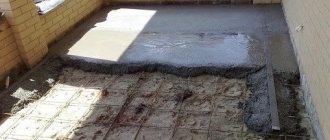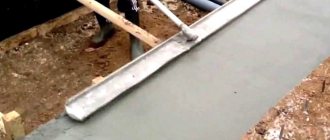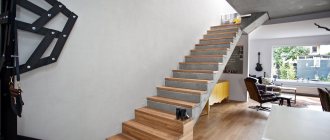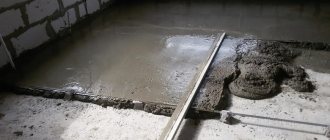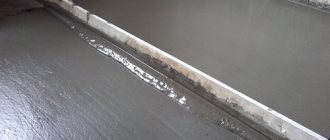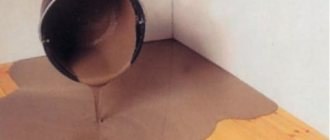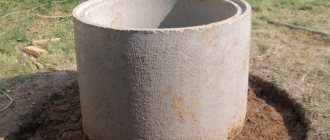Polystyrene concrete screed is distinguished by its ability to retain heat for a long time. This material has many advantages over a simple concrete screed, which is why it is now increasingly used for arranging floors in residential premises. Screeding a floor using polystyrene concrete with your own hands is not difficult, but there are a number of subtleties that need to be taken into account.
Composition of polystyrene concrete
Polystyrene concrete is a specific material that has a cellular structure and is relatively light in weight.
This is a multi-component composition, which includes:
- polystyrene granules 2-5 mm;
- Portland cement M400;
- foaming additives;
- quartz sand;
- plasticizers.
The proportions of the components of the composition depend on the conditions under which the coating will be used in the future. To increase the strength of the solution, the proportion of cement in the ratio of components increases. Approximately 60-80% of the composition should consist of polystyrene granules.
At least 10% should be represented by a special plasticizer, which will increase the plasticity of the solution and reduce the risk of polystyrene granules floating.
The solution must be thoroughly mixed so that the components included in its composition are evenly distributed.
Penoizol
This is a liquid version of polystyrene foam, which has the same pros and cons as the solid version. Its advantage is that it can be poured into hard-to-reach places and, after hardening, forms a monolithic coating without seams.
Penoizol
The disadvantages include the fact that you need to think about the method of supplying penoizol for pouring; on high floors this can be a problem. In most cases, penoizol is used during the construction of private houses; when insulating floors in apartment buildings, it is more convenient to use polystyrene foam and penoplex.
The required thickness of the penoizol layer is the same as that of solid foam.
Advantages
Pouring the floor with polystyrene concrete allows you to create a coating with low thermal conductivity, so additional insulation is not required. In addition, the use of this composition for screed allows you to reduce the load on the base, because it is relatively light.
The advantages of screeds made of expanded polystyrene concrete also include:
- durability;
- filling all cracks;
- good sound insulation;
- environmental friendliness;
- ease of installation.
This coating is highly resistant to rodents. An insulating pie made of polystyrene sheets often becomes a home for rats and mice, but if this material is presented in the form of granules coated with concrete mortar, it is reliably protected from rodents.
The material in granules is highly moisture resistant. It is recommended to be used for arranging floors in bathrooms, kitchens and corridors, as well as in private homes with high air humidity. In addition, this material has a high level of frost resistance. It can withstand at least 100 defrost and freeze cycles.
The hardened material has low vapor permeability, so during its installation there is no need to lay a vapor barrier film. Another advantage of this composition is its non-flammability. Polystyrene granules in concrete mortar are resistant to even open flames.
In addition, when arranging such a screed, there is no need to install additional waterproofing. The screed spreads well, so it fills all the unevenness. Such a coating is easier to mechanically impact than a concrete screed when the need arises to repair utility lines. Another advantage of this coating is the low cost of the components required to create the solution.
Why foam?
The answer to this question is clear: the material has a number of undeniable advantages. For example:
- The structure of the foam is porous, which provides the material with low thermal conductivity. Accordingly, heat will not leave the room, and cold air will not get inside.
- Due to its structure, foam is not affected by moisture. Therefore, in some cases, you can save on laying a layer of waterproofing.
- Polystyrene foam belongs to the category of fireproof materials. It burns, of course, but without the constant presence of an open source of fire it quickly goes out.
- In addition, the material is lightweight, easy to use and is not subject to rotting or destruction over time.
The method of performing foam screed has its own characteristics and nuances. It is worth noting that the technology is quite simple, so absolutely anyone can cope with the work.
Flaws
Despite the fact that polystyrene concrete screed has many positive qualities, it also has some disadvantages. This coating is not recommended for installation in rooms with high vibration load.
The porous structure can quickly crack under the influence of vibration. Thus, this material is not suitable for arranging floors in production workshops and industrial premises.
In addition, polystyrene concrete floor screed has low strength. Any mechanical impact can cause a split. Without a floor covering, the surface wears out quickly. It is necessary to strengthen it with special compounds.
This material has a high degree of shrinkage, so when pouring floors in rooms with a large area, pressing with a vibrating machine is required. When using polystyrene concrete, the surface of the screed is not smooth, which complicates the installation of many types of floor coverings. To level and strengthen the surface, pouring a strengthening mixture may be necessary.
Types and forms of polystyrene foam
Which is better - PSB or EPPS?
Expanded polystyrene is one of the most popular thermal insulation materials. And above all, thanks to its availability and very high insulating qualities. But it can be different - it is either the familiar white foam, or rigid panels of extruded EPS (EPS or, in the English abbreviation XPC). The materials, although made from the same raw materials, have different characteristics at the output. It's all about fundamental differences in production technology.
- Polystyrene foam (PSB) consists of air-filled granules, bonded together during molding in a press. The material can vary greatly in the density and quality of bonding of these very “balls”.
Loose foam granules and slabs obtained during molding under the influence of hot steam.
In loose foam plastic, large air cavities remain between the round granules, into which moisture can easily penetrate, contributing to both a decrease in insulating qualities and rapid deterioration of the material due to erosion. Despite the fact that the granules themselves are waterproof, moisture trapped between them at subzero temperatures can tear the material or even lead to its disintegration into individual granules.
Foam plastic with different densities: only the option with normal density can be considered as slab insulation. The rest won't last long.
The problem is that the simplicity of the technology for producing polystyrene foam encourages many small entrepreneurs to take up this business. And, naturally, a huge part of the products offered for sale are produced in conditions that are very far from normal, without any quality control.
And considering that in many important parameters this “white foam” is seriously inferior to extruded polystyrene foam, it is better not to consider it as a truly high-quality option for floor insulation.
- Extruded polystyrene foam (EPS), unlike PSB, is produced using more sophisticated equipment, so there are practically no low-quality fakes on the market. Of course, this cannot be completely ruled out, but still the likelihood of acquiring outright “junk” is low.
The picture clearly shows the microstructure of extruded polystyrene foam
EPPS is produced from molten raw materials, brought to a foamed state by special additives. This melt is passed through an extruder. The result is strips of specified thickness parameters, and after the material has completely hardened, it is cut into slabs of the required length and width. The dimensions of the slabs have certain standards; each manufacturer may have their own. The thickness of the slabs can be from 10 to 200 mm.
As you can see in the photo presented, the structure of EPS differs significantly from the structure of polystyrene foam. It consists of tiny closed bubbles filled with air, which together form a homogeneous material. Thanks to this structure, extruded polystyrene foam has excellent insulation qualities, high strength characteristics, and is famous for its durability, which is incomparably higher than that of foam plastic.
Among Russian consumers, the most popular EPS brand is Penoplex. It is distinguished by its characteristic orange color.
Comparative characteristics of PSB and EPPS are as follows:
| Name of characteristics | Styrofoam | EPPS |
| Material density, kg/m³ | 15÷35 | 28÷45 |
| Thermal conductivity coefficient, W/(m×℃) | 0,036÷0,050 | 0,028÷0,034 |
| Compressive strength at 10% linear deformation, MPa | 0,05÷0,2 | 0,25÷0,5 |
| Bending strength, MPa | 0,07÷0,20 | 0,4÷1 |
| Moisture absorption, % by volume for 24 hours | 2 | 0.2 |
| Moisture absorption, % by volume for 30 hours | 4 | 0.4 |
| Operating temperature range, ˚С | -50 to +70 | From -70 to +75 |
| Material flammability group | G4 | G4 |
Having examined the characteristics of these two materials, we can come to the conclusion that the best option for floor insulation would be extruded polystyrene foam, which has higher thermal and strength properties.
Extruded polystyrene foam and its advantages
It is not surprising that EPPS is so popular in construction, since, along with accessibility, it has a whole “list” of advantages :
- The material is a highly effective insulation material - in terms of its thermal insulation performance, it significantly exceeds such popular insulation materials as mineral wool and expanded clay.
- EPS is highly resistant to moisture - it does not penetrate its structure, does not reduce its insulating qualities and does not have an erosive effect.
- The affordable price of the material allows you to insulate large areas without too much expense.
- The slabs have a clear geometry and are easy to lay on the prepared surface. For installation on floors under a screed, it is better to choose slabs equipped with one of the types of joint locks, thanks to which you can obtain an almost airtight coating without “cold bridges”.
Eps boards can have straight ends or be equipped with peculiar locks - protrusions or grooves and ridges. For the floor, of course, a locking option would be preferable.
- The material is very light, so it is easy to transport, install and cut. Moreover, you can cut EPS boards with a sharp utility knife or an ordinary hacksaw.
However, the advantages of the material are good, but it is more important to become familiar with its disadvantages , since they are the ones that cause various problems:
- The biggest disadvantage of EPS is its flammability. Despite the fact that the manufacturer positions it as self-extinguishing, in practice even the highest quality material begins to melt and spread, continuing to burn, contributing to the spread of fire.
Of course, if the insulation is laid on a concrete slab, and a cement-sand screed is poured on top of it, then there is no risk of fire. Therefore, EPS can be used for thermal insulation of floors.
- But there is one more caveat specifically from this area. The flammability of EPS is not as dangerous as the smoke it emits during thermal decomposition, which is extremely toxic and often causes tragedies.
- Any polystyrene foam is not an environmentally friendly material. Moreover, this polymer does not have a final stable phase, that is, it may have a tendency to self-destruct. Over time, during the depolymerization process, the insulation may begin to emit toxic fumes that are harmful to the human body. Moreover, even a concrete layer of screed cannot contain these fumes. In connection with this feature (and noted in the previous paragraph), you should think carefully before “letting” expanded polystyrene into residential premises. However, many homeowners are not deterred by these factors at all, and insulation is widely used for thermal insulation of floors and walls of rooms and balconies.
What do you need to know when buying expanded polystyrene?
When purchasing expanded polystyrene, you should pay attention to some nuances
- Extruded polystyrene foam is most often produced by giving it some kind of bright color (orange, blue, yellow). In this case, the slabs must have a uniform color - this factor is a sign that the technology requirements were met during the production of the material.
- The insulation material should not have a strong chemical odor. Most often, high-quality slabs do not smell at all.
- The slabs, as well as their locks, must have a clear geometric shape, then their installation will be easy. The slab must be inspected visually, and also try to join the two slabs together. In addition, the edges of the slabs should not crumble.
The structure of high-quality foam without air cavities
- If you nevertheless purchase polystyrene foam (which, we repeat, is strongly not recommended), then it should at least be of maximum density and consist of granules of the same size. High-quality material should have no voids between the granules.
- The surface of the slabs must be smooth, without dents, otherwise the thermal insulation qualities of the material may be reduced.
Penoplex Comfort
What thickness of insulation will be required?
As mentioned above, expanded polystyrene (of any modification) can be sold in slabs of various thicknesses. What thickness should I choose?
This question has two aspects:
- Firstly, when making calculations, you must remember that the floor level will rise. Even with not the most effective thermal insulation - by 100÷120 mm (insulation boards 30÷50 mm, screed at least 50 mm, plus, possibly, some sheet material (plywood, fiberboard, OSB), and in addition - a finishing decorative coating from 3÷5 mm (linoleum) and up to 15÷20 (laminate with backing, parquet boards, etc.) Therefore, all calculations must be made in advance, taking into account the height of the ceiling in the room, doorways, etc.
- Secondly, the thickness of the insulating material must be such that it provides effective thermal insulation of the floor in order to minimize heat losses.
They need to somehow link these two aspects. At the same time, by the way, it can be taken into account that other materials included in the overall “pie” of the floor structure have thermal insulation qualities, and often very significant ones.
Using expanded polystyrene, the floor is also insulated on the ground. Here, most often, there are no such strict height restrictions as in high-rise buildings. And therefore, very often, preliminary filling with expanded clay is made as additional thermal insulation. This measure allows you to reduce the thickness of the main thermal insulation layer.
You can make the calculations yourself by using the offered online calculator for this purpose. By the way, it includes the ability to calculate insulation both with and without expanded clay. And not only two types of expanded polystyrene, but also other popular insulation materials are considered as possible thermal insulation materials. So in this regard, the calculator can be called universal.
When using this program for the first time, you will probably have questions. Impenetrable explanations are given both in the calculator itself and in the text footnotes below.
Calculator for calculating floor insulation under screed
Go to calculations
Explanations for using the calculator
- First, you need to find, using the map below, the value of the normalized heat transfer resistance for your region of residence. Moreover, of the three values in this case, we are only interested in one - for floors (it is highlighted in blue). This value is indicated in the first field of the calculator (a dot is used as a decimal separator instead of a comma).
Schematic map for determining the normalized value of thermal resistance.
- Well, then you will have to make decisions depending on the planned design of the insulated floor. To do this, half a fairy tale is included in the calculator itself:
Explanation No. 1.
— If the floor is insulated over the ground, and there are no special restrictions on the thickness of the layers, then you can completely limit yourself to one expanded clay - this calculation option is provided in the calculator. In this case, the final value produced by the program will be exactly the thickness of the expanded clay backfill. — A layer of expanded clay alone usually turns out to be too large, and therefore some other, more effective insulation is often used. And its use can also be accompanied by expanded clay pre-fill, or without it.
With this calculation option, additional fields for specifying the initial data and additional explanations will appear.
Explanation No. 2.
If expanded clay is not used in combination with the main insulation, then simply leave the value equal to zero in the field where you need to indicate the planned thickness of the backfill.
Explanation No. 3
It concerns the finishing floor covering. As already mentioned, coating materials can also contribute to the overall thermal insulation picture. But only some of them can be taken seriously. For example, an MDF laminate or linoleum will provide such little resistance to heat transfer that it is easier not to take it into account. Moreover, there is no point in taking ceramic tiles into account. Of all the finishing (or leveling) coating materials, probably only natural wood (boards 15÷20 mm thick or more), equally thick plywood, as well as natural cork, which even with a small thickness can make floors much warmer, deserve attention.
For these materials, after selecting them in the appropriate field, it makes sense to indicate the thickness. For everyone else, you can leave the default thickness of zero.
- The last field in the calculator is popular types of insulation materials. Not all of them are equally good - but I won’t shorten the list. Let them remain at least as an example - you can see how the thickness of the required insulation changes depending on the chosen material.
- It is clear that the result of the calculation is the thickness of the selected insulation. If necessary, it is rounded and reduced to standard thicknesses of materials on sale.
Concrete production
You can mix the polystyrene concrete solution yourself, because... the filler is low in weight. However, to facilitate the process, you can use a concrete mixer and a construction whisk.
It is recommended to purchase a special dry mixture that includes polymer additives, or make it yourself.
To prepare the working solution you will need:
- polystyrene granules - 1 m³;
- cement - 290 kg;
- powder SDO - 0.7 l of concentrate;
- plasticizers;
- water - 120 l.
These components are mixed sequentially until a thick solution is obtained, in which polystyrene foam granules will be evenly distributed.
Preparing the filling mixture
The technology for preparing polystyrene concrete mixture is quite simple. You only need to decide at the initial stage what density you want to obtain and, in accordance with this, prepare the volumes of necessary materials. And don’t forget to add a plasticizer, which is necessary so that the polystyrene granules mix well and do not float.
Advice! Instead of a factory-made plasticizer, you can use liquid soap, shampoo or dishwashing detergent, that is, any concentrated detergent, and add it to the mixture in such an amount that it is enough to stick the polymer granules together.
And so let's start mixing:
- mix cement and polystyrene granules in a container (taking into account that to prepare a fill for 1 mᶟ you will need about 160 kilograms of cement);
- pour water (about 20 liters) and plasticizer (20 milliliters);
- mix the mixture thoroughly with a construction mixer (at least 10 minutes);
- pour the entire prepared mixture into a suitable container and transfer it to the screed site.
Advice! To create a screed, mix the mixture in small portions.
Types of screeds
There are 2 types of polystyrene concrete screeds, incl. thermal insulation and structural. In the first case, a solution is prepared that has a lower density but a higher thermal conductivity coefficient. This composition allows you to create a screed that will retain heat well. However, this variety can withstand less load and is characterized by low resistance to mechanical damage.
The second option involves preparing a dense solution, the weight of which will be 600 kg per 1 m³. This screed is more durable and abrasion resistant, but it will retain heat worse.
Ecowool
Ecowool
This material is very similar in characteristics to mineral wool, but is made from cellulose fibers, therefore it is absolutely safe for health. Just like mineral wool, ecowool is afraid of water and is easily deformed. Therefore, in most cases it is used to insulate wooden floors between floors.
Ecowool insulation
The big advantage of ecowool is that it is installed by spraying under pressure from a special pipe. Thus, the insulation can be “blown out” under the already assembled floor; for this you only need to make several small technological holes.
Spraying ecowool
The required thickness of the ecowool layer corresponds to the thickness of the mineral wool layer, all other things being equal.
Characteristics of basalt and ecowool
Screed manufacturing process
You can fill the screed using polystyrene concrete yourself. You should start by preparing the base. All furniture and other items should be removed from the premises, as well as the old covering should be dismantled.
It is necessary to knock down the sagging of the old mortar if such protrusions are too large. The surface must be cleaned of dirt and dust. Existing cracks in the floor are sealed with cement mortar. Be sure to apply the primer several times to improve the adhesion of the screed to the base.
A damper tape should be glued along the perimeter of the walls, which is necessary to protect the screed from cracking due to the expansion of concrete during temperature changes. The tape must be glued so that it protrudes 3-5 cm above the level of the screed.
After this, beacons should be placed. You can use metal guides, cords or wooden blocks. Using a laser level, you need to check that the guides are installed correctly. Then you can start mixing the solution and pouring it.
Mixing the solution
If a ready-made dry mixture is used to fill the screed, you should use the instructions given by the manufacturer when preparing the solution.
When carrying out work yourself, you should make the mixture in small portions, because... polystyrene has a large volume. However, if you have a spacious container and it is possible to simultaneously knead the required amount of solution, you can prepare it immediately.
First, polystyrene granules are poured into the container in which the solution will be prepared and about 10% water is added. The mass is thoroughly mixed with a construction whisk so that the granules get wet.
After this, cement is added. It is necessary to add approximately 85% water to the mixture and mix the mass thoroughly. SDO should be dissolved in the remaining water and added to the container. After this, it is necessary to bring the composition to the consistency of sour cream.
Foaming agent alternative
Special additives to increase the porosity of concrete are not always commercially available. However, replacements are easy to find. When preparing the solution, at the last stage you should add detergent diluted in a small amount of water to the mixture. When mixing, it will form foam, and this will saturate the composition with a large number of air bubbles.
Filling and Alignment
Before installing the screed, thoroughly moisten the base. For this you can use cement laitance or water. This is necessary to improve the adhesion of the solution to the surface. Then you can begin installing the screed. Its thickness should be from 3 to 8 cm. The mixture should be carefully laid out between the beacons so that it rises above them by 1-2 cm. As a rule, the surface should be leveled to the level of the beacons. In this case, you need to ensure that there are no cavities in the screed.
In the room where the foundation work is being carried out, it is necessary to close all doors and windows so that drafts do not affect the screed. If necessary, after initial setting, the beacons can be removed.
To improve the drying of the solution and accelerate its strength gain, it is recommended to cover the surface of the base with plastic film for up to 7 days.
If the room in which flooring work is being carried out is more than 30 m², it is recommended to leave damper joints uncovered. This will reduce the risk of surface cracking in the future. Approximately 14 days after the work, you can fill it with a self-leveling mixture. Its thickness should be 3-5 cm. When it hardens, you can begin decorative finishing.
Preparatory stage
The algorithm for this stage looks like this:
- First, we clean the floor surface from dust and construction debris;
- We check for differences in floor height using a level, as well as for the presence of chips, depressions, protrusions and cracks;
- if there are protrusions, we chop them off; if there are depressions and other irregularities, fill them with a solution prepared from a quick-drying repair cement mixture;
- We stick damper tape around the entire perimeter of the room (to avoid cracking of the finished screed);
- we install the profiles on self-tapping screws fixed to the base (the step between the screws is 100 cm, the step between rows is 170-180 cm);
- We begin to prepare the solution.
Analogues of polystyrene concrete
Analogues of polystyrene concrete are aerated concrete and foam concrete. These materials are lightweight and at the same time have similar sound and heat insulation properties. However, gas and foam concrete are less often used for floor screed. Most often the choice is between dry screed and polystyrene concrete.
Dry screed is convenient because it does not involve wet stages of creating a coating. In addition, cracks cannot appear on it (even at the beginning of use immediately after installation). But it is necessary to take into account that the coating based on dry screed does not tolerate high humidity and has low heat and sound insulation characteristics in comparison with polystyrene concrete. The cost of screeds made from these materials is almost the same.
Features of calculating the thickness of insulation
Polystyrene slabs come in different thicknesses and densities; to choose the best option, you need to take into account several factors:
- climatic conditions;
- type of heat insulator;
- type and thickness of the finishing floor covering.
If a material is used for the finishing floor that does not have thermal insulation characteristics, for example, ceramic tiles, or its thickness is too small, then it is not taken into account in the calculation. You can calculate the thickness of the material using an online calculator. You can also consult a specialist of the relevant profile.
A number of factors must be taken into account when making calculations if insulation is carried out on the ground or in a room above a cold basement. For an apartment, polystyrene with a thickness of 30-50 mm is usually sufficient. Consider the height of the ceilings, the thickness of the screed and other factors.
Layers of concrete floor on the ground
The ground floor is a multi-layer structure.
Let's analyze it layer by layer.
- After installing the strip foundation, the soil is backfilled. To prevent the plant layer of soil from getting into the backfill, the turf is removed before the trench is dripped under the foundation.
- The backfill soil is compacted, and the level of the earthen floor is leveled horizontally.
- A sand cushion is made on the ground. The cushion sand is compacted using a tamping machine; it can be rented at a tool rental. For better compaction, the sand is generously moistened with water. The thickness of the sand cushion is 60 mm.
- An underlying layer of gravel or crushed stone is made on top of the sand cushion. Expanded clay is not recommended for use due to possible soil moisture. Crushed stone is also compacted and leveled. The thickness of the gravel or crushed stone layer is 80 mm.
- Waterproofing is done on top of the crushed stone layer using rolled materials. The joining of materials is done with an overlap of 20-30 cm. The joining of rolls is also insulated from moisture.
Concrete base layer
The next layer is a layer of rough concrete floor with reinforcement. Its thickness is 80 mm. B22.5 concrete is used. The following types of concrete screeds are acceptable:
- Concrete screed;
- Reinforced concrete screed;
- Reinforced concrete screed;
- Screed, reinforced concrete with the addition of fiber (SFB);
- Screed made of reinforced concrete reinforced with the addition of fiber (SFRC).
Note: The screed reinforcement is standard, steel mesh with cells 100 by 100 millimeters.
Overview of glue manufacturers
The main composition of adhesive solutions for polystyrene concrete products includes: water, Portland cement, mineral compounds, which include small granules of foamed polystyrene. The unique formula of the adhesive allows the surface layer to be endowed with hydrophobic, thermal insulation and properties. Useful components impart rot-resistant properties and reliable load-bearing qualities to the finished walls. Special adhesive compositions are presented on the market in the form of dry mixtures, suitable for both external and internal use. Before use, you will need to dilute the powder with water and mix thoroughly.
Adhesives of various brands for polystyrene concrete have a narrow focus, but have distinctive characteristics from each other. Each manufacturer's main goal is to stand out among competitors. Therefore, they focus on different properties. For example, one mixture has increased plasticity, while another has the main property of durability. It is recommended not to buy the most expensive option, but to consider manufacturers who have positive reviews from consumers.
Popular brands of dry adhesive and masonry building materials suitable for polystyrene concrete blocks:
- "Polystyrene" G-32 is a universal cement-sand mixture for external and internal use. The material differs from independently prepared compositions, since during the production process special impurities are added that regulate the influence of water permeability, atmospheric and biological stability. The composition has a frost resistance rating of 200 cycles and 10 minutes of adjustment time. The recommended thickness of seams is minimum 2 mm, maximum 8 mm.
- Betonkol is an adhesive mixture with increased viability, intended for building materials consisting of lightweight concrete. You can work with the prepared solution for up to four hours, but the time for adjustment is 5 minutes. maximum. Frost resistance properties - 200 cycles, has high peel strength. It is recommended to apply a layer of 2-5 mm.
- Construction adhesive "Keraflex" - designed for laying polystyrene concrete blocks and cellular concrete. The mixture is universal, has a high level of frost resistance and strength. Viability is 3 hours, and time for correction is 5-7 minutes. The manufacturer does not recommend using the adhesive solution at temperatures below + 5 degrees C. The thickness of the seams is from 2 to 10 mm.
- "Bolars" is an adhesive for blocks made of light compounds, an excellent option for carrying out repair work in winter. The minimum temperature is -10 degrees C. In comparison with the above compositions, this mixture has an increased compressive strength of 7.5 MPa. Typically, adhesives have no more than 5 MPa. Frost resistance is 50 cycles, 10 minutes are allotted for adjustment. The recommended thickness of seams is from 2-8 millimeters.
- “Blok” is a waterproof, frost-resistant, weather-resistant adhesive, suitable for installation on almost all lightweight concrete products. This universal mixture is characterized by high tensile strength and compression strength - 20 MPa. Viability up to 3 hours, correction of blocks up to 7 minutes.
Some developers and private builders claim that blocks can be laid using tile adhesive mortar. This opinion is erroneous, since the composition of such a mixture is intended for a different texture of building material, which has different qualities. When laying polystyrene concrete blocks, it is necessary to use adhesive solutions specially designed for this purpose. Otherwise, there will be a decrease in the physical and mechanical performance of the finished building.
